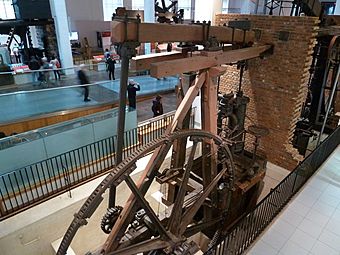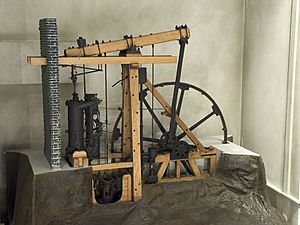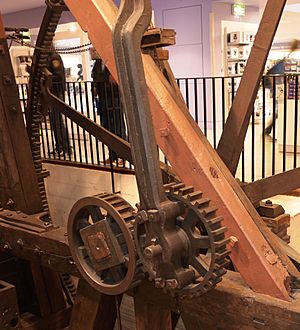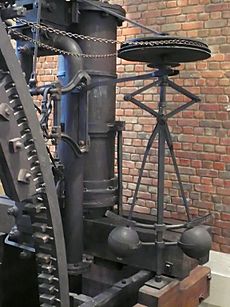Lap Engine facts for kids
Quick facts for kids Lap Engine |
|
|---|---|
 |
|
| Origins | |
| Type | Watt rotative beam engine |
| Designer | James Watt |
| Maker | Boulton and Watt |
| Date | 1788 |
| Country of origin | England |
| Former operator | Soho Manufactory |
| Purpose | Driving factory machinery |
| Measurements | |
| Cylinders | 1 |
| Bore | 18.75 inches (47.6 cm) |
| Stroke | 4 feet (1.2 m) |
| Preservation | |
| Collection | Science Museum Group |
| Location | Science Museum, London |
| Accession no. | 1861–46 |
| Working | No |
The Lap Engine is a special type of steam engine called a beam engine. It was designed by the famous inventor James Watt and built by his company, Boulton and Watt, in 1788. Today, you can see it at the Science Museum, London.
This engine is very important because it was one of the first steam engines to use all of Watt's big improvements. It helped change how factories worked by making machines move in a circle, which is called rotary motion.
The engine got its name because it was used in Matthew Boulton's factory, the Soho Manufactory. There, it powered 43 machines that polished things like buttons and buckles. This polishing process was called lapping.
Contents
Watt's Engine Innovations

It's important to know that James Watt didn't invent the steam engine itself. Instead, he made many clever changes that greatly improved the engines that already existed, like the Newcomen atmospheric engine. The Lap Engine, along with the Whitbread Engine (built in 1785), are some of the first engines that included all of Watt's major improvements.
Parallel Motion System
One of Watt's key inventions was the parallel motion system. This clever mechanical linkage made sure that the piston inside the engine moved in a perfectly straight line. This was very important for the engine to work smoothly and efficiently.
Rotative Beam Engines
Early steam engines mostly created an up-and-down motion. Watt's rotative beam engines were designed to change this up-and-down movement into a spinning, circular motion. This was a huge step forward because it meant steam engines could power factory machines that needed to spin, like grinding wheels or looms.
Sun and Planet Gear
To turn the up-and-down motion into spinning motion, engines often use a crankshaft. However, at the time, another inventor had a patent for using a crankshaft with a steam engine. Watt didn't want to pay to use it, so he looked for another way.
His employee, a Scottish engineer named William Murdoch, came up with the sun and planet gear. Watt patented this invention in 1781.
The sun and planet gear is a simple type of gear system. Imagine one gear (the "planet") attached to the engine's moving rod. As the rod moves up and down, the planet gear spins around another gear (the "sun"). This clever design makes the sun gear, which is connected to the output shaft, spin twice as fast as it would with a regular crankshaft. This was a big advantage because beam engines moved slowly, but the factory machines they powered needed to spin quickly.
Centrifugal Governor
The Lap Engine was also special because it was one of the first steam engines to have a centrifugal governor. This device automatically controls the engine's speed. If the engine starts to go too fast, the governor uses spinning weights to reduce the steam flow, slowing it down. If it goes too slow, it increases the steam flow. This kept the engine running at a steady speed, which was very important for factory work.



